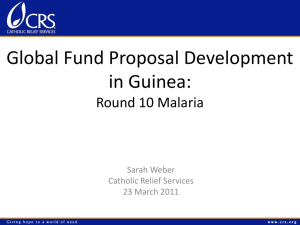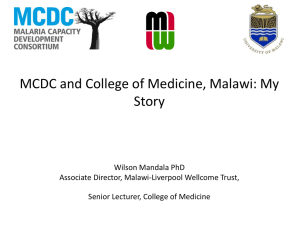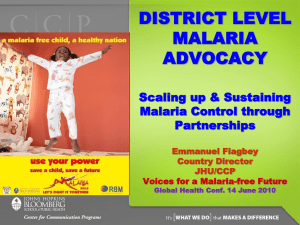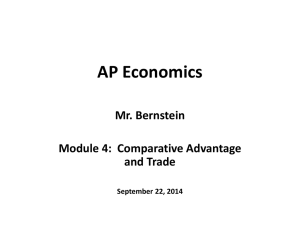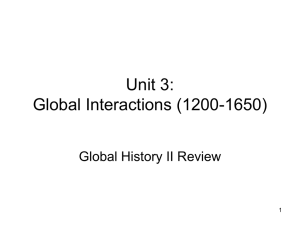karma.global warming
advertisement
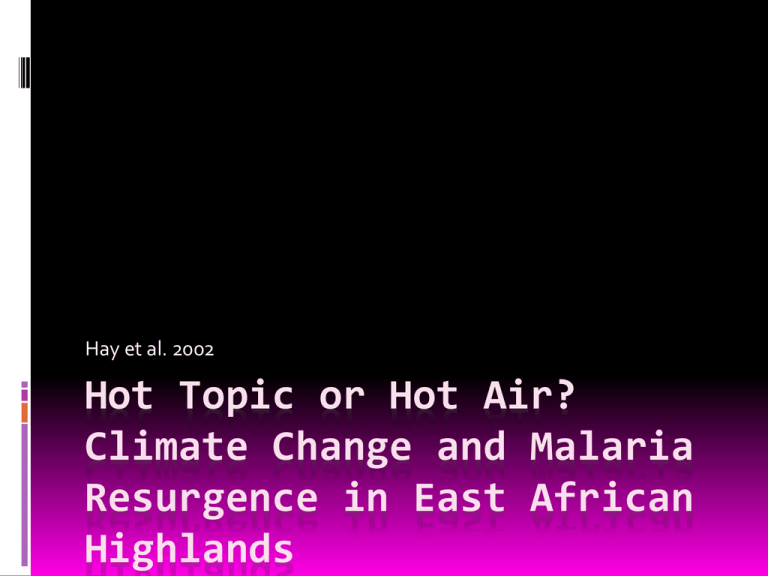
Hay et al. 2002 Hot Topic or Hot Air? Climate Change and Malaria Resurgence in East African Highlands Climate Change and Malaria Climate warming Increase in malaria outbreaks? Re-emergence of other vector born diseases? Mosquitoes (Genus: Anopheles) expanding their range coinciding with warming temperatures and increased precipitation? A digital elevation model showing reported malaria resurgence in high altitude regions of East Africa: A – Debre Zeit, Ethiopia B – Kericho, Kenya C – Kabale, Uganda D – Gikonko, Rwanda E – Muhanga, Burundi F – Amani, Tanzania G – Analaroa, Madagascar Percentage change of incidence of Plasmodium falciparum malaria (1980 -2000) Meteorological Changes No significant changes in climate in Kericho, Kabale, Gikonko, Amani or Muhanga as reported by an ADF test Debre Zeit and Analaroa experienced significant warming (1970 – 1995) Both lie at the edge of the East African highlands Greatest increase in malaria Other Factors? Other Factors Drug resistance Vector control Health service provision Land use change Population growth and urbanization Drug Resistance Focussing on Chloroquine resistance First appeared in East Africa in 1978 Spread to all tropical African countries Still the major drug used in these areas Examples of Drug Resistance Example 1: Kericho (Kenya) Chloroquine resistance likely cause of malaria resurgence No change in climate, environment, population structure, health care, or malaria control measures Examples of Drug Resistance Example 2: Gikonko (Rwanda) Believed malaria resurgence a result of climate change Significance of temperature trends not tested Drug resistance was dismissed as a possible cause Examples of Drug Resistance Example 3: Burundi Four measurements were taken, between 1993 and 2001, to support climate change as a mechanism for malaria resurgence No statistical analysis Measurements from one area Unmistakable evidence for Chloroquine resistance in the area Vector Control Africa once had effective vector-control programmes DDT application There has been a decrease in these vector control services and these decreases correspond with increases in malaria resurgence Examples of Vector Control Example 1: Debre Zeit (Ethiopia) 26 000 kg of DDT per annum (1965 - 1979) down to 4000 kg (1980 - 1993) Resurgence in malaria Example 2: Madagascar Huge epidemic in 1878 makes malaria endemic to the country 1949 eradication programme – very successful Spraying terminated in 1960 followed by treatment centers in 1979 Severe epidemic in 1988 1993 spraying re-introduced Health Service Provision In East Africa: Population served by hospital beds has increased (1980-1990) Exception is Rwanda Overall there is a decrease in health services in these regions Occurring at the same time as the malaria resurgence The percentage change in population per hospital bed using data for 1980 and for 1990 Land-use Change Measure level of vegetation cover using NDVI Positive correlation between increased vegetation and malaria Most sites showed an increase in vegetation cover (<8%) Occurring at the same time as the malaria resurgence The percentage change in normalized difference vegetation index (NDVI); the 1981-1985 average is compared with the 1996-2000 average for each site Population Growth and Urbanization In East African countries population increase by 50% since 1980 Population has doubled in urban areas to 26% in 2000 44% by 2030 Reduction of malaria risk in urban populations The percentage change in the human population – total (open bars) and urban (solid bars) – between 1980 and 2000 Conclusion Climate change could be playing a role in malaria resurgence in the East African highlands The evidence for this is weak Five of seven sites experienced no significant change in climate Other factors at play including: increased drug resistance decreased vector control decreasing health services increase in vegetation growing population These factors track more closely with trends in malaria resurgence than climate change alone Gething et al. 2010 Climate Change and the Global Malaria Recession Climate Change Models and Malaria Global malaria endemicity has declined in the past 100 years Malaria control projects Affordable treatment Urbanization (Hay et al. 2002) Current belief is that global climate change will increase the future global range and intensity of malaria Based on model predictions Accuracy of models not been challenged Recent Evidence Comparison map of global malaria prevalence from 1900 to 2007 Covers a period of undoubted climate change Observe changes in range Observe changes in endemicity Compared results to recent models which predict the impact of future changes in climate on the range or intensity of malaria Based on the current relationship between temperature and vectors Global Malaria 1900 • Map of parasite rates as the proportion of individuals with Plasmodium species in their peripheral blood (PR) • Hypoendemic – PR < 10% • Mesoendemic – PR ≥ 10% Pre-intervention endemicity (approximately 1900) and < 50% • Hyperendemic - PR ≥ 50% and < 75% • Holoendemic – PR ≥ 75% • Endemic malaria covered up to 58% of the globe Global Malaria 2007 • Endemic malaria present • • • Contemporary endemicity for 2007 based on a recent global project to define the limits and intensity of current P. falciparum transmission • • in only 30% of the globe In tropics mainly Holoendemic malaria is rare (patches in West Africa) North America, Europe and Russsia essentially risk free South America is hypoendemic or unstable Most of central and southeast Asia is hypoendemic or unstable Change in Endemicity between 1900 and 2007 The range of malaria has been reduced (previous figures) but also its prevalence In most areas Change in endemicity class between 1900 and 2007. Negative values denote a reduction in endemicity, positive values and increase experiencing stable malaria transmission, endemicity fell by one or more classes (67%) Only a few locations had a rise in endemicity Results of Comparison Comparison between current climate change model predictions with the historical and contemporary maps show: Increase in temperature does not necessarily mean an increase in range or intensity of malaria Despite the known effects of temperature on the range of the mosquito vector Non-climatic factors must be playing a greater role in determining the prevalence of malaria Climate-Biological Model Directly predict the effect of future climate change on the spread of malaria and then compare this to the effect that non-climatic factors have on malaria Found that non-climatic factors acting to reduce global malaria in the 20th century reduced transmission rates more so than the future increase in global temperature will ever increase malaria transmission Conclusion Using the comparison maps and climate- biological models: In order for climate warming to increase malaria transmission it must surpass the collective effects of disease control programmes and urbanization which act to reduce malaria transmission global temperature increases will not cause an increase in malaria endemicity To ensure malaria endemicity continues to decline, funding should be given to disease control programmes to keep them current and effective Referenes Gething, P. W., D. L. Smith, A. P. Patil, A. J. Tatem, R. W. Snow and S. I. Hay. 2010. Climate change and the global malaria recession. Nature 465: 342–345 Hay, S. I., D. J. Rogers, S. E. Randolph, D. I. Stern, J. Cox, G. D. Shanks and R. W. Snow. 2002. Hot topic or hot air? Climate change and malaria resurgence in East African highlands. Trends in Parasitology 18: 530 – 534
